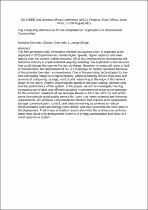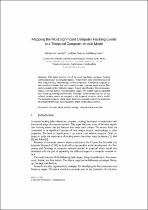 ResearchSpace
ResearchSpace
Fog computing architecture for 5G-Compliant IoT applications in underserved communities
JavaScript is disabled for your browser. Some features of this site may not work without it.
- ResearchSpace
- →
- Research Publications/Outputs
- →
- Conference Publications
- →
- View Item
| dc.contributor.author |
Khumalo, Nosipho N

|
|
| dc.contributor.author |
Oyerinde, O

|
|
| dc.contributor.author |
Mfupe, Luzango P

|
|
| dc.date.accessioned | 2020-02-07T06:03:57Z | |
| dc.date.available | 2020-02-07T06:03:57Z | |
| dc.date.issued | 2019-08 | |
| dc.identifier.citation | Khumalo, N.N., Oyerinde, O. and Mfupe, L.P. 2019. Fog computing architecture for 5G-Compliant IoT applications in underserved communities. 2019 IEEE 2nd Wireless Africa Conference (WAC), Pretoria, South Africa, South Africa, 18-20 August 2019, 5pp | en_US |
| dc.identifier.isbn | 978-1-7281-3618-9 | |
| dc.identifier.isbn | 978-1-7281-3619-6 | |
| dc.identifier.uri | https://ieeexplore.ieee.org/document/8843414 | |
| dc.identifier.uri | DOI: 10.1109/AFRICA.2019.8843414 | |
| dc.identifier.uri | https://events.vtsociety.org/wirelessafrica2019/conference-sessions/program-detail/ | |
| dc.identifier.uri | http://hdl.handle.net/10204/11299 | |
| dc.description | Copyright: 2019 IEEE. Due to copyright restrictions, the attached PDF file only contains the abstract of the full text item. For access to the full text item, kindly consult the publisher's website. | en_US |
| dc.description.abstract | The fifth generation (5G) of wireless network ecosystem which is expected to be deployed in 2020 promises to provide higher speeds, higher capacity and lower latency than the current mobile networks. 5G is also envisioned to revolutionise the telecoms industry in unprecedented ways by enabling new applications and services that could change the way we live and do things. However, in areas with poor or lack of infrastructure, the deployment of 5G is a challenge for mobile operators because of the potential low return on investment. One of the promising technologies for low cost computing networks is fog computing, which selectively moves resources and services of computing, storage, control and networking at the edge of the network closer to the users, thereby improving the speed of decision-making, network cost, and the performance of the system. In this paper, we aim to investigate how fog computing can enable cost-efficient solutions in underserved areas to compensate for the economic drawback of low Average Revenue Per User (ARPU), and at the same time provide good quality service for users that meets essential performance requirements. We propose a fog-based architecture that exploits local computation, storage, communication, control, and decision making as a means to reduce communication costs and energy consumption and thus overcome the cost issue in 5G deployment. Preliminary simulation results show that the architecture performs better than cloud-only deployments in terms of energy consumption and delay in a smart agriculture system. | en_US |
| dc.language.iso | en | en_US |
| dc.publisher | IEEE | en_US |
| dc.relation.ispartofseries | Worklist;22730 | |
| dc.subject | 5G mobile communication | en_US |
| dc.subject | Cloud computing | en_US |
| dc.subject | Computer architecture | en_US |
| dc.subject | Computational modeling | en_US |
| dc.subject | Edge computing | en_US |
| dc.subject | Internet of Things | en_US |
| dc.subject | Sensors | en_US |
| dc.title | Fog computing architecture for 5G-Compliant IoT applications in underserved communities | en_US |
| dc.type | Conference Presentation | en_US |
| dc.identifier.apacitation | Khumalo, N. N., Oyerinde, O., & Mfupe, L. P. (2019). Fog computing architecture for 5G-Compliant IoT applications in underserved communities. IEEE. http://hdl.handle.net/10204/11299 | en_ZA |
| dc.identifier.chicagocitation | Khumalo, Nosipho N, O Oyerinde, and Luzango P Mfupe. "Fog computing architecture for 5G-Compliant IoT applications in underserved communities." (2019): http://hdl.handle.net/10204/11299 | en_ZA |
| dc.identifier.vancouvercitation | Khumalo NN, Oyerinde O, Mfupe LP, Fog computing architecture for 5G-Compliant IoT applications in underserved communities; IEEE; 2019. http://hdl.handle.net/10204/11299 . | en_ZA |
| dc.identifier.ris | TY - Conference Presentation AU - Khumalo, Nosipho N AU - Oyerinde, O AU - Mfupe, Luzango P AB - The fifth generation (5G) of wireless network ecosystem which is expected to be deployed in 2020 promises to provide higher speeds, higher capacity and lower latency than the current mobile networks. 5G is also envisioned to revolutionise the telecoms industry in unprecedented ways by enabling new applications and services that could change the way we live and do things. However, in areas with poor or lack of infrastructure, the deployment of 5G is a challenge for mobile operators because of the potential low return on investment. One of the promising technologies for low cost computing networks is fog computing, which selectively moves resources and services of computing, storage, control and networking at the edge of the network closer to the users, thereby improving the speed of decision-making, network cost, and the performance of the system. In this paper, we aim to investigate how fog computing can enable cost-efficient solutions in underserved areas to compensate for the economic drawback of low Average Revenue Per User (ARPU), and at the same time provide good quality service for users that meets essential performance requirements. We propose a fog-based architecture that exploits local computation, storage, communication, control, and decision making as a means to reduce communication costs and energy consumption and thus overcome the cost issue in 5G deployment. Preliminary simulation results show that the architecture performs better than cloud-only deployments in terms of energy consumption and delay in a smart agriculture system. DA - 2019-08 DB - ResearchSpace DP - CSIR KW - 5G mobile communication KW - Cloud computing KW - Computer architecture KW - Computational modeling KW - Edge computing KW - Internet of Things KW - Sensors LK - https://researchspace.csir.co.za PY - 2019 SM - 978-1-7281-3618-9 SM - 978-1-7281-3619-6 T1 - Fog computing architecture for 5G-Compliant IoT applications in underserved communities TI - Fog computing architecture for 5G-Compliant IoT applications in underserved communities UR - http://hdl.handle.net/10204/11299 ER - | en_ZA |








